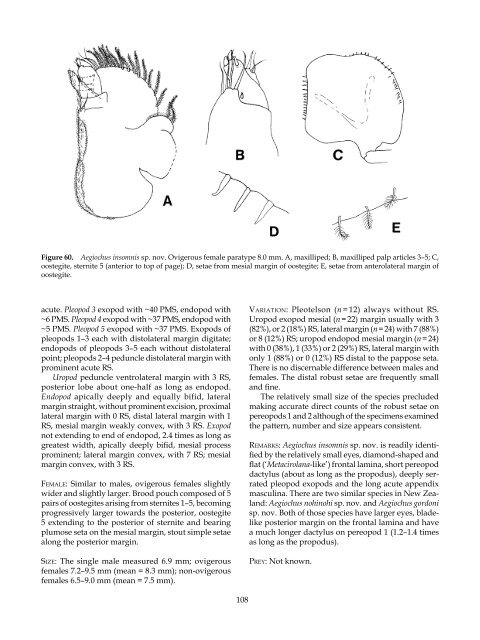The Marine Fauna of New Zealand: Isopoda, Aegidae (Crustacea)
The Marine Fauna of New Zealand: Isopoda, Aegidae (Crustacea)
The Marine Fauna of New Zealand: Isopoda, Aegidae (Crustacea)
You also want an ePaper? Increase the reach of your titles
YUMPU automatically turns print PDFs into web optimized ePapers that Google loves.
Figure 60. Aegiochus insomnis sp. nov. Ovigerous female paratype 8.0 mm. A, maxilliped; B, maxilliped palp articles 3–5; C,<br />
oostegite, sternite 5 (anterior to top <strong>of</strong> page); D, setae from mesial margin <strong>of</strong> oostegite; E, setae from anterolateral margin <strong>of</strong><br />
oostegite.<br />
acute. Pleopod 3 exopod with ~40 PMS, endopod with<br />
~6 PMS. Pleopod 4 exopod with ~37 PMS, endopod with<br />
~5 PMS. Pleopod 5 exopod with ~37 PMS. Exopods <strong>of</strong><br />
pleopods –3 each with distolateral margin digitate;<br />
endopods <strong>of</strong> pleopods 3–5 each without distolateral<br />
point; pleopods 2–4 peduncle distolateral margin with<br />
prominent acute RS.<br />
Uropod peduncle ventrolateral margin with 3 RS,<br />
posterior lobe about one-half as long as endopod.<br />
Endopod apically deeply and equally bifid, lateral<br />
margin straight, without prominent excision, proximal<br />
lateral margin with 0 RS, distal lateral margin with<br />
RS, mesial margin weakly convex, with 3 RS. Exopod<br />
not extending to end <strong>of</strong> endopod, 2.4 times as long as<br />
greatest width, apically deeply bifid, mesial process<br />
prominent; lateral margin convex, with 7 RS; mesial<br />
margin convex, with 3 RS.<br />
femaLe: Similar to males, ovigerous females slightly<br />
wider and slightly larger. Brood pouch composed <strong>of</strong> 5<br />
pairs <strong>of</strong> oostegites arising from sternites –5, becoming<br />
progressively larger towards the posterior, oostegite<br />
5 extending to the posterior <strong>of</strong> sternite and bearing<br />
plumose seta on the mesial margin, stout simple setae<br />
along the posterior margin.<br />
size: <strong>The</strong> single male measured 6.9 mm; ovigerous<br />
females 7.2–9.5 mm (mean = 8.3 mm); non-ovigerous<br />
females 6.5–9.0 mm (mean = 7.5 mm).<br />
08<br />
Variation: Pleotelson (n = 2) always without RS.<br />
Uropod exopod mesial (n = 22) margin usually with 3<br />
(82%), or 2 ( 8%) RS, lateral margin (n = 24) with 7 (88%)<br />
or 8 ( 2%) RS; uropod endopod mesial margin (n = 24)<br />
with 0 (38%), (33%) or 2 (29%) RS, lateral margin with<br />
only (88%) or 0 ( 2%) RS distal to the pappose seta.<br />
<strong>The</strong>re is no discernable difference between males and<br />
females. <strong>The</strong> distal robust setae are frequently small<br />
and fine.<br />
<strong>The</strong> relatively small size <strong>of</strong> the species precluded<br />
making accurate direct counts <strong>of</strong> the robust setae on<br />
pereopods and 2 although <strong>of</strong> the specimens examined<br />
the pattern, number and size appears consistent.<br />
remarks: Aegiochus insomnis sp. nov. is readily identified<br />
by the relatively small eyes, diamond-shaped and<br />
flat (‘Metacirolana-like’) frontal lamina, short pereopod<br />
dactylus (about as long as the propodus), deeply serrated<br />
pleopod exopods and the long acute appendix<br />
masculina. <strong>The</strong>re are two similar species in <strong>New</strong> <strong>Zealand</strong>:<br />
Aegiochus nohinohi sp. nov. and Aegiochus gordoni<br />
sp. nov. Both <strong>of</strong> those species have larger eyes, bladelike<br />
posterior margin on the frontal lamina and have<br />
a much longer dactylus on pereopod ( .2– .4 times<br />
as long as the propodus).<br />
prey: Not known.

















